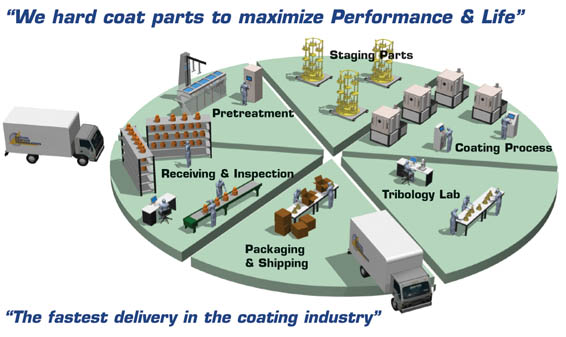


Cathodic Arc Physical Vapor Deposition
(a type of PVD)
PVD Process Simply:
The PVD process uses vacuum, target material (e.g. Titanium), heat, electrical potential and
gasses such as nitrogen to deposit a coating on the substrate. The substrate is put into the
chamber and connected to electrical source to enable a potential voltage difference. The
chamber is evacuated and heated to high temperatures (100-600°C). A small amount of gas
(Nitrogen for TiN) is bled into the PVD chamber. A plasma cloud is then ignited which evaporates
the target material and deposits the coating on the substrate in a controlled and precise manner.
Different target materials and gasses are used to create different coatings with different properties.
These PVD coatings can increase the Rockwell 'C' hardness of steel up to 4 times that of plain
steel as well as reduce the coefficient of friction.
Commercial PVD coatings are simply a product of a metal and a gas excited under vacuum
with heat and electricity to combine in a way they can not under atmospheric conditions. The
metal cathodes inside the chamber on the inner walls facing the parts and the corresponding
plasma field created from gas precisely bled into the chamber are the main constituents of
the process.
For example, a Titanium plate in an Argon (inert gas) and Nitrogen plasma field creates
Titanium Nitride or the gold colored TiN. A Chromium metal plate and Nitrogen plasma field
produce CrN. Mixed alloys (Titanium and Aluminum) plus Nitrogen create TiAlN. The difference
between AlTiN and TiAlN is only the concentration of Ti to Al where the highest one comes first.
AlTiN has more Aluminum while TiAlN has more Titanium.
The C in coatings (TiCN versus TiN) stands for Carbon that is passed into the plasma field
using a simple gas like Acetylene (C2H2). The molecule is cracked; hydrogen evacuated
leaving the Carbon behind to interact with the Nitrogen and Ionized Metal creating titanium
carbonitride (TiCN).
The only difference between TiCN and TiN is the carbon from an additional process gas.
The effect if controlled correctly creates a much lower coefficient of friction material with
increased toughness. With carbon in the mix TiCN is a new material with its own properties
now different than TiN.
Layering these materials (alternating Tin and TiCN) creates a composite structure with
enhanced properties. Many little layers are currently referred to 'nano layers' (10-9 meter in
thickness) while older or specific processes call for monolithic or mono-layered materials.
Mono-layered material is a single layer of a specific material while multi-layered or
nano-composite structures have a few to dozens of specifically tailored layers of material
to enhance certain material properties including controlling internal stresses.
In summary: Titanium or other certain metals are vaporized from a solid source (cathode)
by means of an electric arc to form a plasma vapor. The resulting, highly charged, metal ions
from the plasma are then mixed with inert gas such as nitrogen. The positively charged plasma
is attracted to the negatively charged substrate (object being coated) producing a thin, uniform,
colored metallic film on its surface.
"At DCT we differentiate ourselves from our competition with product quality, rapid delivery,
and by providing many levels of world class support services. Our flexibility in addressing
real time engineering solutions is one of our strongest competitive advantages. When you
seek our support, DCT provides trained coatings professionals with a wide array of
manufacturing experiences. We provide more than thin layered products. Dayton Coating
Technologies provides Thin Coating Solutions to improve our customers performance
and profitability." George Korenyi-Both, President and Founder of Dayton Coating
Technologies, LLC (1999).
Coating Applications Support
Engineers are available to review applications with you personally,
make recommendations and visit on site to evaluate specific uses. This way,
the most appropriate coating is selected maximizing your competitive advantage.
Development of Differentiated Products
Often customers with niche applications prefer the use of proprietary coating configurations.
These coatings have specific performance qualities in certain areas. We can support any product
differentiation initiative through advanced coating research, testing, and development.
Coating Related Production Testing
The regular testing and evaluation of coating performance is an important step to ensuring
product quality. Our state of the art tribological surface study laboratory is ready and available.
We certify and test every run, every day for all of our customers components. Additional testing
capability is available. The development of component specific tests, DOE, program management,
and PPAP submissions are no problem. Our experienced engineers and scientists will work
with your organization seamlessly to interpret and develop test standards/equipment.

